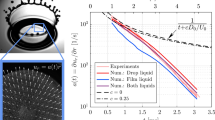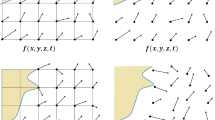Abstract
In this work, a moving droplet impacting a moving particle is investigated for a wide range of impact conditions: particle–droplet density ratio (1 ≤ Ω ≤ 10), Bond number (0.177 ≤ Bo ≤ 1.765), and Reynolds number (16.381 ≤ Re ≤ 32.763), by using the lattice Boltzmann method (LBM) coupled with a modified immersed boundary method. Six key results are obtained. (1) Three collision regimes are identified in this work: separation, deposition, and agglomeration. (2) The separation regime can be split into two sub-regimes: separation-I and separation-II. (3) And the agglomeration also has two sub-regimes: agglomeration-I and agglomeration-II. In the available literature, the agglomeration-II was discussed only for a droplet impacting a fixed particle, but never for a moving particle. (4) For deposition and agglomeration, the vertical velocity of the particle experiences three stages, while for separation, the vertical velocity of the particle can be classified into four stages. (5) For separation-II process, the vertical velocity of the droplet is larger than its particle counterpart. (6) A regime map for Re–Ω is concluded.























Similar content being viewed by others
Data Availability Statement
This manuscript has associated data in a data repository. [Authors’ comment: The datasets generated during and/or analysed during the current study are available from the corresponding author on reasonable request.].
References
C. Andronache, Estimated variability of below-cloud aerosol removal by rainfall for observed aerosol size distributions. Atmos. Chem. Phys. 3, 131–143 (2003)
D.M. Chate, T.S. Pranesha, Field studies of scavenging of aerosols by rain events. J. Aerosol. Sci. 35(6), 695–706 (2004)
V.M. Kerminen, H. Lihavainen, M. Komppula, Y. Viisanen, M. Kulmala, Direct observational evidence linking atmospheric aerosol formation and cloud droplet activation. Geophys. Res. Lett. 32(14) (2005).
D.O. Topping, G. McFiggans, Tight coupling of particle size, number and composition in atmospheric cloud droplet activation. Atmos. Chem. Phys. 12(7), 3253–3260 (2012)
M.A. Ratcliff, B. Windom, G.M. Fioroni, P. St John, S. Burke, J. Burton, E.D. Christensen, P. Sindler, R.L. McCormick, Impact of ethanol blending into gasoline on aromatic compound evaporation and particle emissions from a gasoline direct injection engine. Appl. Energy 250, 1618–1631 (2019)
M. Medina, F.M. Alzahrani, M. Fatouraie, M.S. Wooldridge, V. Sick, Mechanisms of fuel injector tip wetting and tip drying based on experimental measurements of engine-out particulate emissions from gasoline direct-injection engines. Int J Engine Res 22(6), 2035–2053 (2021)
H. Yi, J. Seo, Y.S. Yu, Y. Lim, S. Lee, J. Lee, H. Song, S. Park, Effects of lubricant-fuel mixing on particle emissions in a single cylinder direct injection spark ignition engine. Sci. Rep. 12(1), 18 (2022)
L. Li, I. Kemp, M. Palmer, A DEM-based mechanistic model for scale-up of industrial tablet coating processes. Powder Technol. 364, 698–707 (2020)
M. Khoder, V. Schropp, S. Zeitler, B. Pereira, R. Habashy, P.G. Royall, J.T.W. Wang, M.A. Alhnan, A novel natural GRAS-grade enteric coating for pharmaceutical and nutraceutical products. Int. J. Pharmaceut. 584, 119392 (2020)
V. Verma, K.M. Ryan, L. Padrela, Production and isolation of pharmaceutical drug nanoparticles. Int. J. Pharmaceut. 603, 120708 (2021)
Z. Zhao, D. Poulikakos, J. Fukai, Heat transfer and fluid dynamics during the collision of a liquid droplet on a substrate—I modeling. Int. J. Heat Mass Transf. 39(13), 2771–2789 (1996)
Y. Ge, L.S. Fan, Droplet-particle collision mechanics with film-boiling evaporation. J. Fluid Mech. 573, 311–337 (2007)
A.G. Islamova, S.A. Kerimbekova, N.E. Shlegel, P.A. Strizhak, Droplet-droplet, droplet-particle, and droplet-substrate collision behavior. Powder Technol. 403, 117371 (2022)
X. Liu, X. Zhang, J.C. Min, Maximum spreading of droplets impacting spherical surfaces, Phys. Fluids 31(9) (2019)
X. Liu, X. Zhang, J.C. Min, Droplet rebound and dripping during impact on small superhydrophobic spheres, Phys Fluids, 34(3) (2022).
A. Bordbar, A. Taassob, D. Khojasteh, M. Marengo, R. Kamali, Maximum spreading and rebound of a droplet impacting onto a spherical surface at low weber numbers. Langmuir 34(17), 5149–5158 (2018)
S.A. Banitabaei, A. Amirfazli, Droplet impact onto a solid sphere: Effect of wettability and impact velocity, Phys. Fluids 29(6) (2017)
S. Bakshi, I.V. Roisman, C. Tropea, Investigations on the impact of a drop onto a small spherical target, Phys. Fluids 19(3) (2007)
G.T. Liang, Y.L. Guo, X.S. Mu, S.Q. Shen, Experimental investigation of a drop impacting on wetted spheres. Exp. Therm. Fluid Sci. 55, 150–157 (2014)
H.N. Dalgamoni, X. Yong, Numerical and theoretical modeling of droplet impact on spherical surfaces, Phys. Fluids 33(5) (2021)
M.J. Sayyari, S.F. Kharmiani, J.A. Esfahani, A lattice Boltzmann study on dripping process during 2D droplet impact onto a wetted rotating cylinder. J. Mol. Liq. 275, 409–420 (2019)
D. Khojasteh, N.M. Kazerooni, M. Marengo, A review of liquid droplet impacting onto solid spherical particles: a physical pathway to encapsulation mechanisms. J. Ind. Eng. Chem. 71, 50–64 (2019)
V.V. Dubrovsky, A.M. Podvysotsky, A.A. Shraiber, Particle interaction in three-phase polydisperse flows. Int. J. Multiph. Flow 18(3), 337–352 (1992)
S.K. Pawar, F. Henrikson, G. Finotello, J.T. Padding, N.G. Deen, A. Jongsma, F. Innings, J.A.M.H. Kuipers, An experimental study of droplet-particle collisions. Powder Technol. 300, 157–163 (2016)
L. Pasternak, M.J.M. Manas, M. Sommerfeld, Influence of droplet properties on the coating of free-falling spherical particles. At. Sprays 31(2), 37–61 (2021)
P.P. Tkachenko, N.E. Shlegel, P.A. Strizhak, Experimental research of liquid droplets colliding with solid particles in a gaseous medium. Chem. Eng. Res. Des. 177, 200–209 (2022)
N.G. Deen, M.V. Annaland, J.A.M. Kuipers, Direct numerical simulation of complex multi-fluid flows using a combined front tracking and immersed boundary method. Chem. Eng. Sci. 64(9), 2186–2201 (2009)
G.Q. Wu, S. Chen, Simulating the collision of a moving droplet against a moving particle: Impact of Bond number, wettability, size ratio, and eccentricity, Phys. Fluids 33(9) (2021)
G.Q. Wu, S. Chen, Comparison of droplet-particle interaction on a stationary and a moving particle. Chem. Eng. Sci. 253, 117552 (2022)
G.Q. Wu, S. Chen, W.H. Du, S. Zhai, S.B. Zeng, Y. Yu, W.G. Zhou, Simulation on a three-dimensional collision of a moving droplet against a moving super-hydrophobic particle. Powder Technol. 405, 117558 (2022)
G.Q. Wu, S. Chen, Simulating spray coating processes by a three-dimensional lattice Boltzmann method-immersed boundary method approach. Chem. Eng. Sci. 263, 118091 (2022)
C. Chung, M. Lee, K. Char, K.H. Ahn, S.J. Lee, Droplet dynamics passing through obstructions in confined microchannel flow. Microfluid. Nanofluid. 9(6), 1151–1163 (2010)
Q. Li, Z. Chai, B. Shi, H. Liang, Deformation and breakup of a liquid droplet past a solid circular cylinder: a lattice Boltzmann study. Phys. Rev. E 90(4), 043015 (2014)
C.Y. Zhang, H. Zhang, Y.G. Zhao, C. Yang, An immersed boundary-lattice Boltzmann model for simulation of deposited particle patterns in an evaporating sessile droplet with dispersed particles. Int. J. Heat Mass Transf. 181, 121905 (2021)
S.F. Zhao, A. Riaud, G.S. Luo, Y. Jin, Y. Cheng, Simulation of liquid mixing inside micro-droplets by a lattice Boltzmann method. Chem. Eng. Sci. 131, 118–128 (2015)
M.C. Sukop, D. Or, Lattice Boltzmann method for modeling liquid-vapor interface configurations in porous media, Water Resour. Res. 40(1) (2004)
L. Chen, Q.J. Kang, Y.T. Mu, Y.L. He, W.Q. Tao, A critical review of the pseudopotential multiphase lattice Boltzmann model: Methods and applications. Int. J. Heat Mass Transf. 76, 210–236 (2014)
S.K. Kang, Y.A. Hassan, A direct-forcing immersed boundary method for the thermal lattice Boltzmann method. Comput. Fluids 49(1), 36–45 (2011)
Z.-G. Feng, E.E. Michaelides, The immersed boundary-lattice Boltzmann method for solving fluid–particles interaction problems. J. Comput. Phys. 195(2), 602–628 (2004)
K. Han, Y.T. Feng, D.R.J. Owen, Coupled lattice Boltzmann and discrete element modelling of fluid–particle interaction problems. Comput. Struct. 85(11–14), 1080–1088 (2007)
Z.L. Guo, C.G. Zheng, Analysis of lattice Boltzmann equation for microscale gas flows: relaxation times, boundary conditions and the Knudsen layer. Int. J. Comput. Fluid D 22(7), 465–473 (2008)
P. Yuan, L. Schaefer, Equations of state in a lattice Boltzmann model, Phys. Fluids 18(4) (2006)
X.Y. He, G.D. Doolen, Thermodynamic foundations of kinetic theory and Lattice Boltzmann models for multiphase flows. J. Stat. Phys. 107(1–2), 309–328 (2002)
R. Benzi, L. Biferale, M. Sbragaglia, S. Succi, F. Toschi, Mesoscopic modeling of a two-phase flow in the presence of boundaries: the contact angle. Phys. Rev. E 74(2), 021509 (2006)
S. Tao, Q. He, J.C. Chen, B.M. Chen, G. Yang, Z.B. Wu, A non-iterative immersed boundary-lattice Boltzmann method with boundary condition enforced for fluid-solid flows. Appl. Math. Model 76, 362–379 (2019)
H.R. Liu, H. Ding, A diffuse-interface immersed-boundary method for two-dimensional simulation of flows with moving contact lines on curved substrates. J. Comput. Phys. 294, 484–502 (2015)
W.W. Ren, C. Shu, J. Wu, W.M. Yang, Boundary condition-enforced immersed boundary method for thermal flow problems with Dirichlet temperature condition and its applications. Comput. Fluids 57, 40–51 (2012)
B. Yang, S. Chen, Simulation of interaction between a freely moving solid particle and a freely moving liquid droplet by lattice Boltzmann method. Int. J. Heat Mass Transf. 127, 474–484 (2018)
S. Mitra, G.M. Evans, E. Doroodchi, V. Pareek, J.B. Joshi, Interactions in droplet and particle system of near unity size ratio. Chem. Eng. Sci. 170, 154–175 (2017)
V. Mehdi-Nejad, J. Mostaghimi, S. Chandra, Air bubble entrapment under an impacting droplet. Phys. Fluids 15(1), 173–183 (2003)
N. Li, Y.Q. Zhao, Q. Pan, S.G. Kong, Demosaicking DoFP images using Newton’s polynomial interpolation and polarization difference model. Opt. Express 27(2), 1376–1391 (2019)
J. Wang, O.M. Faltinsen, C. Lugni, Unsteady hydrodynamic forces of solid objects vertically entering the water surface, Phys. Fluids 31(2) (2019)
J.P. Wang, E. Gallo, B. Francois, F. Gabrieli, P. Lambert, Capillary force and rupture of funicular liquid bridges between three spherical bodies. Powder Technol 305, 89–98 (2017)
S.M. You, M.P. Wan, Mathematical Models for the van der Waals force and capillary force between a rough particle and surface. Langmuir 29(29), 9104–9117 (2013)
I. Malgarinos, N. Nikolopoulos, M. Gavaises, A numerical study on droplet-particle collision dynamics. Int. J. Heat Fluid Flow 61, 499–509 (2016)
H. Tavana, F. Simon, K. Grundke, D.Y. Kwok, M.L. Hair, A.W. Neumann, Interpretation of contact angle measurements on two different fluoropolymers for the determination of solid surface tension. J. Colloid Interface Sci. 291(2), 497–506 (2005)
M. Jamali, A. Rostamijavanani, N.M. Nouri, M. Navidbakhsh, An experimental study of cavity and Worthington jet formations caused by a falling sphere into an oil film on water. Appl. Ocean Res. 102, 102319 (2020)
G.Q. Wu, S. Chen, W.H. Du, S.B. Zeng, Y. Yu, S. Zhai, Y. Wang, On the collision of a droplet with a V-shaped wall. Int. Commun. Heat Mass 137, 106269 (2022)
K. Petschel, S. Stellmach, M. Wilczek, J. Lulff, U. Hansen, Kinetic energy transport in Rayleigh-Benard convection. J. Fluid Mech. 773, 395–417 (2015)
Author information
Authors and Affiliations
Corresponding author
Rights and permissions
Springer Nature or its licensor (e.g. a society or other partner) holds exclusive rights to this article under a publishing agreement with the author(s) or other rightsholder(s); author self-archiving of the accepted manuscript version of this article is solely governed by the terms of such publishing agreement and applicable law.
About this article
Cite this article
Wu, G., Chen, S. Direct numerical simulation of a moving droplet impacting a moving particle: effects of particle–droplet density ratio, Bond number, and Reynolds number. Eur. Phys. J. Plus 138, 723 (2023). https://doi.org/10.1140/epjp/s13360-023-04354-x
Received:
Accepted:
Published:
DOI: https://doi.org/10.1140/epjp/s13360-023-04354-x




